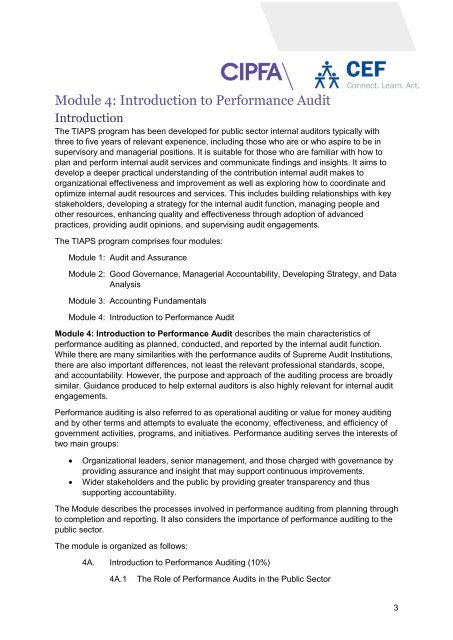Create successful ePaper yourself
Turn your PDF publications into a flip-book with our unique Google optimized e-Paper software.
<strong>Module</strong> 4: <strong>Introduction</strong> <strong>to</strong> <strong>Performance</strong> <strong>Audit</strong><br />
<strong>Introduction</strong><br />
The TIAPS program has been developed for public sec<strong>to</strong>r internal audi<strong>to</strong>rs typically with<br />
three <strong>to</strong> five years of relevant experience, including those who are or who aspire <strong>to</strong> be in<br />
supervisory and managerial positions. It is suitable for those who are familiar with how <strong>to</strong><br />
plan and perform internal audit services and communicate findings and insights. It aims <strong>to</strong><br />
develop a deeper practical understanding of the contribution internal audit makes <strong>to</strong><br />
organizational effectiveness and improvement as well as exploring how <strong>to</strong> coordinate and<br />
optimize internal audit resources and services. This includes building relationships with key<br />
stakeholders, developing a strategy for the internal audit function, managing people and<br />
other resources, enhancing quality and effectiveness through adoption of advanced<br />
practices, providing audit opinions, and supervising audit engagements.<br />
The TIAPS program comprises four modules:<br />
<strong>Module</strong> 1: <strong>Audit</strong> and Assurance<br />
<strong>Module</strong> 2: Good Governance, Managerial Accountability, Developing Strategy, and Data<br />
Analysis<br />
<strong>Module</strong> 3: Accounting Fundamentals<br />
<strong>Module</strong> 4: <strong>Introduction</strong> <strong>to</strong> <strong>Performance</strong> <strong>Audit</strong><br />
<strong>Module</strong> 4: <strong>Introduction</strong> <strong>to</strong> <strong>Performance</strong> <strong>Audit</strong> describes the main characteristics of<br />
performance auditing as planned, conducted, and reported by the internal audit function.<br />
While there are many similarities with the performance audits of Supreme <strong>Audit</strong> Institutions,<br />
there are also important differences, not least the relevant professional standards, scope,<br />
and accountability. However, the purpose and approach of the auditing process are broadly<br />
similar. Guidance produced <strong>to</strong> help external audi<strong>to</strong>rs is also highly relevant for internal audit<br />
engagements.<br />
<strong>Performance</strong> auditing is also referred <strong>to</strong> as operational auditing or value for money auditing<br />
and by other terms and attempts <strong>to</strong> evaluate the economy, effectiveness, and efficiency of<br />
government activities, programs, and initiatives. <strong>Performance</strong> auditing serves the interests of<br />
two main groups:<br />
<br />
<br />
Organizational leaders, senior management, and those charged with governance by<br />
providing assurance and insight that may support continuous improvements.<br />
Wider stakeholders and the public by providing greater transparency and thus<br />
supporting accountability.<br />
The <strong>Module</strong> describes the processes involved in performance auditing from planning through<br />
<strong>to</strong> completion and reporting. It also considers the importance of performance auditing <strong>to</strong> the<br />
public sec<strong>to</strong>r.<br />
The module is organized as follows:<br />
<strong>4A</strong>. <strong>Introduction</strong> <strong>to</strong> <strong>Performance</strong> <strong>Audit</strong>ing (10%)<br />
<strong>4A</strong>.1 The Role of <strong>Performance</strong> <strong>Audit</strong>s in the Public Sec<strong>to</strong>r<br />
3
















